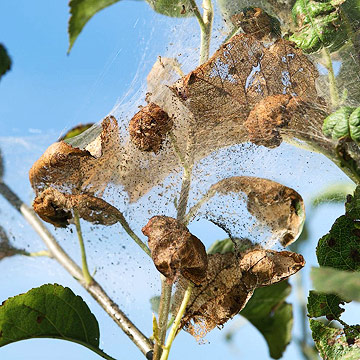






It happens like clockwork. Your late-summer garden is looking great and then all of a sudden you see big, horrible webs in your trees and shrubs. Inside these webs are colonies of caterpillars munching away at your trees' leaves.
Webworms are the caterpillar form of a small white moth. The moths fly around during the summer laying their eggs on the underside of tree leaves. The moths seem to prefer alder, willow, cottonwood, apple, pear, peach, pecan, walnut, elm, and maples, but will eat a very large variety of trees and shrubs.
As the eggs hatch, the caterpillars start to spin a web around the leaves they're on. They feed for about six weeks and their webs can reach more than 3 feet across. This is when they look their worst.
continue reading belowBefore panicking, the first thing you should know is that these webworms don't typically cause a lot of damage to trees and shrubs. They look far worse than they are. So if you don't mind them, the most organic approach is to simply let them be. Even if they defoliate your tree, it's usually late enough in the season that it doesn't harm your tree.
In small trees, the most effective solution can be to physically remove the webbing with a shovel, rake, or even a big stick. In larger trees, you can also prune out the affected branches. Throw the nests in the trash.
Even if you can't completely remove the nests, don't worry. Simply damaging them and opening up a hole is enough to allow birds or beneficial insects to get rid of the pests for you.
Several species of insects, including a number of tiny wasps, attack and kill webworms for you. Encourage beneficial insects by planting sunflowers or other plants in the daisy family in your yard. Or purchase beneficial wasps from an online supplier.
A bacterium called Bt infects and kills many species of caterpillars, including fall webworms. A natural caterpillar disease, Bt won't cause damage to plants, people, or pets. Bt is most effective if you can break a hole in the webbing to spray the disease onto the pests. Note: Bt does affect the caterpillars of many butterflies.
Neem is one of a host of organic insecticides available. This product is derived from a tropical tree and can be very effective at getting rid of pests. Note: While neem is organic, it will kill many beneficial insects, so spray with care.
Copyright © www.100flowers.win Botanic Garden All Rights Reserved